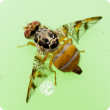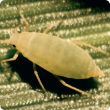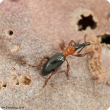Crops
The Department of Primary Industries and Regional Development continues to support the growth and international competitiveness of all crop industries in Western Australia.
With a 2400 kilometre span from its tropical north to its temperate south, WA supports a broad range of cropping industries from rain-fed winter cereals through to irrigated horticultural crops.
In the 2012/13 year the WA cropping industries exported a total of $3.9 billion which comprised: $3.1 billion of cereals, $859 million of pulses, pastures and oilseeds, $142 million of horticultural crops. The major contributors to these exports were wheat ($2.7 billion), canola ($756 million), barley ($377 million), lupins ($42 million), carrots at $48 million, oats ($12 million), and strawberries at $5.5 million.
Filter by search
Filter by topic
- (-) Remove Pests filter Pests
- Pests, weeds & diseases (113) Apply Pests, weeds & diseases filter
- (-) Remove Pest insects filter Pest insects
- Horticulture (67) Apply Horticulture filter
- Grains (42) Apply Grains filter
- Fruit (33) Apply Fruit filter
- Vegetables (28) Apply Vegetables filter
- Canola (18) Apply Canola filter
- Biosecurity & quarantine (18) Apply Biosecurity & quarantine filter
- Potatoes (17) Apply Potatoes filter
- Biosecurity (15) Apply Biosecurity filter
- Plant biosecurity (14) Apply Plant biosecurity filter
- Cabbage (11) Apply Cabbage filter
- Pome fruit (10) Apply Pome fruit filter
- Citrus (9) Apply Citrus filter
- Lupins (8) Apply Lupins filter
- Diseases (8) Apply Diseases filter
- Grapes & wine (8) Apply Grapes & wine filter
- Stone fruit (7) Apply Stone fruit filter
- Grains research & development (7) Apply Grains research & development filter
- Crop diseases (6) Apply Crop diseases filter
- Wheat (5) Apply Wheat filter
- Nursery & cutflowers (5) Apply Nursery & cutflowers filter
- Barley (5) Apply Barley filter
- Quarantine (4) Apply Quarantine filter
- Pulses (4) Apply Pulses filter
- Cauliflower (4) Apply Cauliflower filter
- New horticulture crops (4) Apply New horticulture crops filter
- Control methods (4) Apply Control methods filter
- Olives (3) Apply Olives filter
- Insecticides (3) Apply Insecticides filter
- Weeds (3) Apply Weeds filter
- Emergency response (3) Apply Emergency response filter
- Production & postharvest (3) Apply Production & postharvest filter
- Chinese cabbage (3) Apply Chinese cabbage filter
- Broccoli (3) Apply Broccoli filter
- Agricultural emergency response (3) Apply Agricultural emergency response filter
- Chemicals (3) Apply Chemicals filter
- Brussels sprouts (3) Apply Brussels sprouts filter
- Kale (2) Apply Kale filter
- Mangoes (2) Apply Mangoes filter
- Minor fruits (2) Apply Minor fruits filter
- Intrastate movement (2) Apply Intrastate movement filter
- Nematodes (2) Apply Nematodes filter
- Climate, land & water (2) Apply Climate, land & water filter
- Biosecurity and Agriculture Management Act (2) Apply Biosecurity and Agriculture Management Act filter
- Biosecurity governance (2) Apply Biosecurity governance filter
- Crop weeds (2) Apply Crop weeds filter
- Field peas (2) Apply Field peas filter











